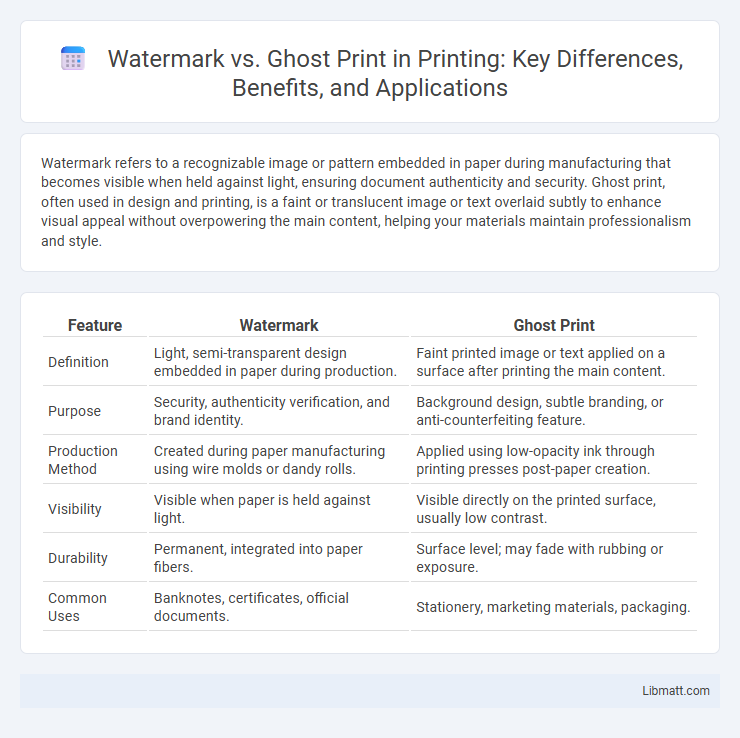Watermark refers to a recognizable image or pattern embedded in paper during manufacturing that becomes visible when held against light, ensuring document authenticity and security. Ghost print, often used in design and printing, is a faint or translucent image or text overlaid subtly to enhance visual appeal without overpowering the main content, helping your materials maintain professionalism and style.
Table of Comparison
| Feature | Watermark | Ghost Print |
|---|---|---|
| Definition | Light, semi-transparent design embedded in paper during production. | Faint printed image or text applied on a surface after printing the main content. |
| Purpose | Security, authenticity verification, and brand identity. | Background design, subtle branding, or anti-counterfeiting feature. |
| Production Method | Created during paper manufacturing using wire molds or dandy rolls. | Applied using low-opacity ink through printing presses post-paper creation. |
| Visibility | Visible when paper is held against light. | Visible directly on the printed surface, usually low contrast. |
| Durability | Permanent, integrated into paper fibers. | Surface level; may fade with rubbing or exposure. |
| Common Uses | Banknotes, certificates, official documents. | Stationery, marketing materials, packaging. |
Introduction to Watermark and Ghost Print
Watermark and ghost print are advanced printing techniques used to enhance security and authenticity in documents. Watermarks are embedded patterns or images visible when held against light, commonly found in banknotes and official papers, providing a covert yet verifiable element. Ghost prints, or ghost images, appear as faint, semi-transparent imprints on paper, often used in packaging and branding to ensure originality without obstructing the primary content.
Definition and Purpose of Watermark
A watermark is a transparent design or pattern embedded into paper during manufacturing to indicate authenticity and deter counterfeiting. Its primary purpose is to provide a subtle security feature that is visible when held against light, enhancing document legitimacy in banknotes, certificates, and legal papers. Unlike ghost prints, which are faint images typically created during the printing process, watermarks are integral to the paper itself and serve as a permanent anti-fraud measure.
Definition and Purpose of Ghost Print
Ghost print refers to a faint, translucent image or pattern embedded in paper or fabric to enhance security and authenticity without overwhelming the main design. It serves as a covert anti-counterfeiting measure, often used in currency, official documents, and high-quality textiles to verify legitimacy. Unlike watermarks, ghost prints are visible under normal lighting conditions but designed to blend subtly with the background.
Key Differences Between Watermark and Ghost Print
Watermarks are embedded into paper during manufacturing, creating a visible or translucent design when held against light, primarily used for security and authenticity verification. Ghost prints refer to faint, residual images or impressions left unintentionally during printing, often considered defects rather than security features. Understanding these key differences helps you distinguish intentional watermarking from unintentional ghost prints in documents or artwork.
Applications in Document Security
Watermarks and ghost prints serve critical roles in document security by providing authentication and deterring counterfeiting; watermarks are embedded during paper manufacturing, making them difficult to replicate, while ghost prints are faint, translucent images added during printing to enhance document integrity. Your choice between watermark and ghost print depends on the required security level, with watermarks often used for official government papers and currency, and ghost prints commonly found on checks and confidential business documents. Both technologies support anti-fraud measures by enabling easy verification of genuine documents through visual or UV light inspection.
Visual Appearance and Detection Methods
Watermarks are typically embedded into paper fibers, displaying subtle, translucent images or patterns visible when held against light, while ghost prints appear as faint, blurred duplicates of text or images on the document surface. Detection of watermarks often requires backlighting or transmitted light techniques, making them easily identifiable under specific lighting conditions, whereas ghost prints are detected through close visual inspection or image scanning technologies that highlight inconsistencies in ink density and clarity. These contrasting visual appearances and detection methods are crucial for verifying document authenticity and preventing forgery.
Technological Processes Involved
Watermark creation involves embedding a subtle design into paper during the manufacturing process using wire patterns or roller dandy rolls, which manipulate paper fibers to form translucent images visible when held against light. Ghost printing employs digital or traditional printing techniques to produce faint, low-opacity images on the surface of the paper, creating a "ghosted" visual effect without altering the paper's physical structure. Understanding these technological processes helps you select the appropriate security or design feature based on your project's requirements for authenticity and visual subtlety.
Pros and Cons of Watermarks
Watermarks offer strong protection against unauthorized use by embedding visible or semi-transparent designs into images or documents, enhancing brand recognition and authenticity. However, they can sometimes distract from the content and reduce visual appeal, potentially affecting user experience or viewer engagement. Your choice depends on whether prevention of misuse or preserving aesthetic quality is more critical for your content.
Pros and Cons of Ghost Print
Ghost print offers subtle branding and security benefits by embedding faint text or images that are difficult to replicate, enhancing product authenticity and reducing counterfeiting risks. However, its low visibility can limit its effectiveness in marketing or visual appeal, and it may be overlooked by consumers seeking clearer brand identification. The technique demands precise printing technology, which can increase production costs and complexity compared to traditional watermark methods.
Choosing Between Watermark and Ghost Print
Choosing between watermark and ghost print depends on the desired visibility and security level for the document. Watermarks offer a subtle, embedded image or text that is visible when held against light, providing moderate protection and authenticity verification. Ghost prints are faint prints on documents or fabrics, primarily for aesthetic enhancement with minimal impact on security features.
Watermark vs Ghost Print Infographic

 libmatt.com
libmatt.com